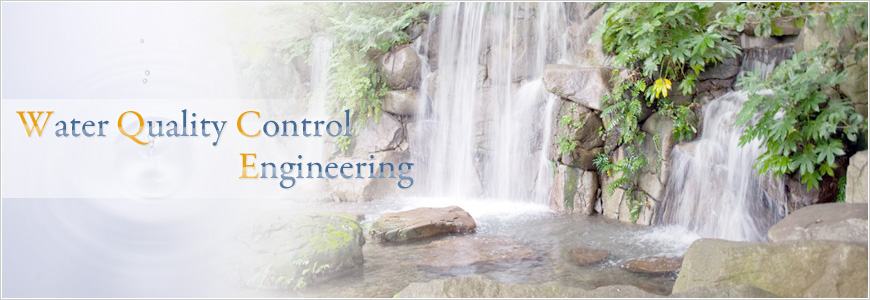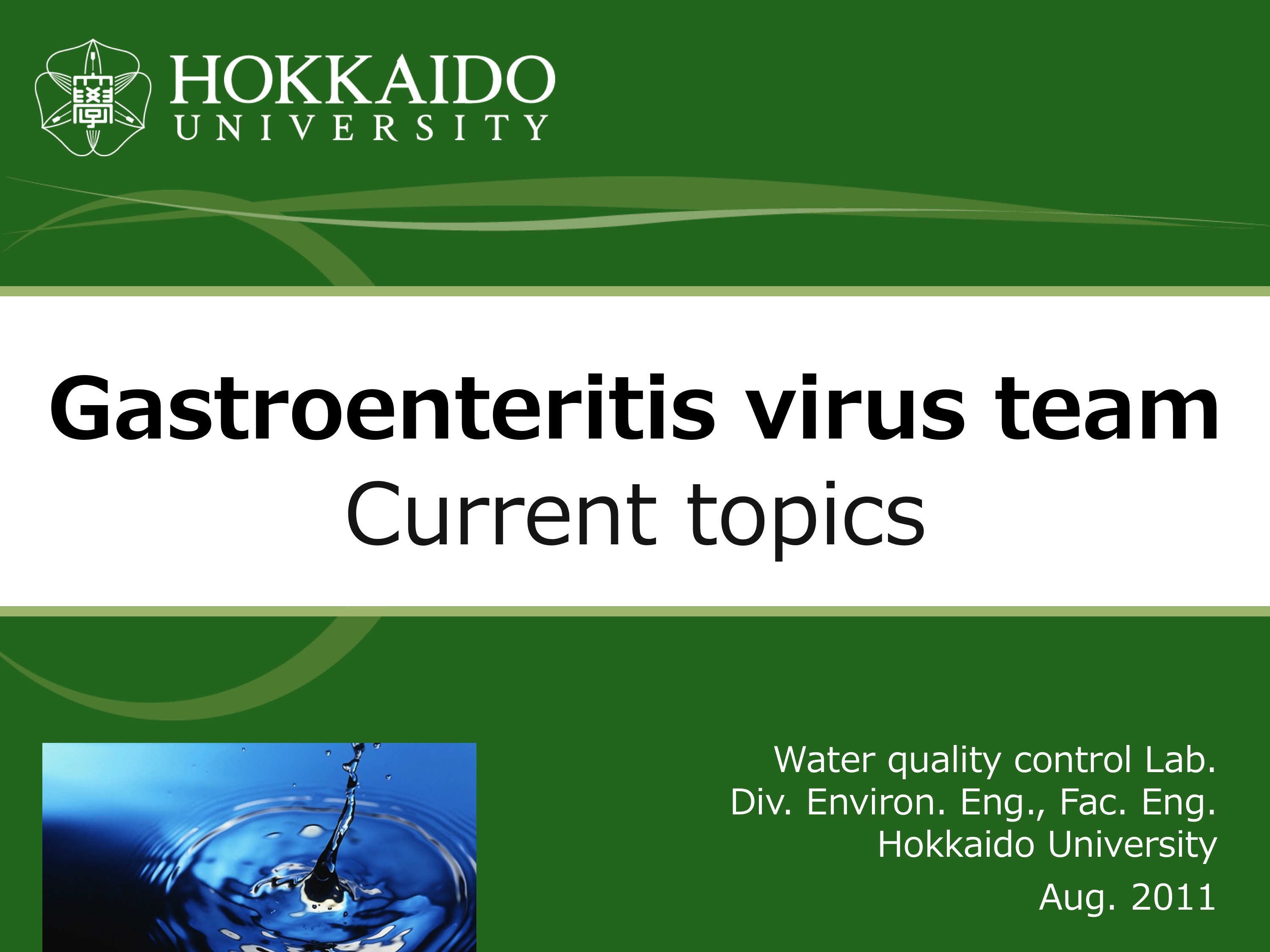Water pollution with pathogenic viruses, mainly non-enveloped enteric viruses, is one of the growing concerns all over the world, because these pathogenic viruses in reservoir, river water and seawater pose infectious disease risks via drinking water, recreation water and marine cultured products. Since a large amount of excreted pathogenic viruses from infected individuals flow into sewage streams, removal and inactivation of these viruses in wastewater treatment processes is really important to prevent water environment from the viral pollution. A variety of disinfection processes, including chlorine related oxidants, ultraviolet (UV) irradiation, ozonation and photocatalysis, have been proposed for inactivating pathogenic viruses in water, and mechanisms of viral inactivation with several disinfection processes have been suggested. However, the presence of non-cultivatable viruses, which has no cell culture and animal model available for assaying their infectivity, makes the situation complicated, because it is impossible to comprehend the effects of these disinfection processes on non-cultivatable viruses by the loss of their infectivity. The information of disinfection effectiveness on these non-cultivatable viruses is invaluable and indispensable to control these viruses under human administration. One important approach to address this issue is to establish cell lines that can replicate currently non-cultivatable viruses, but the difficulty of this approach has been described. One of the other important viewpoints in the environmental virology is that waterborne pathogenic viruses that could newly emerge in the near future are presumably non-cultivatable, because they have not been ever trapped and found notwithstanding the intensive monitoring by a lot of researchers using a variety of cell culture for a long time. The establishment of cell lines that can propagate non-cultivatable viruses has been very critical and indispensable for the study of pathogenicity and life cycles of pathogenic viruses, but it is not possible for environmental sanitarians to wait it to address the recent need for the evaluation of the safety in the usage of water and marine products.
In our study group, a new approach to evaluate the viral particle integrity has been proposed, in which cumulative oxidative damages on viral capsid protein are directly detected. Non-enveloped enteric viruses could be injured by exogenous stresses, and the lesions on viral capsid protein would lead to the inability for viruses to recognize cellular receptors to initiate infection. This means that the integrity of viral capsid protein is very critical for estabilishing a viral life cycle. In the proposed approach, cumulative oxidative damages on viral particle are detected by labeling with a biotin hydrazide that can form covalent bond with carbonyl groups (Figure indicated below). Residues of several amino acids, including lysine, arginine, tyrosine and prorine can be oxidized by several chemicals, and carbonyl groups are formed on these residues. It is well known that the carbonylation on protein molecules caused by oxidative stresses bring about the loss of protein functions. Biotin hydrazide could react with carbonylated capsid protein of viruses, and oxidatively damaged capsid protein could be modified with biotin. Biotin-modified (= damaged) virus particles are separated from intact virions with avidin-immobilized affinity chromatography. In order to confirm the accumulation of the oxidative damages on viral capsid proteins cause the infectivity loss of viruses, astrovirus and rotavirus have been employed as test viruses. Furthermore, this approach of the detection of oxidative damages with biotin hydrazide and avidin column was applied to human norovirus, an important etiological agent, purified from a fecal sample of gastroenteritis patient. We are going to apply this approach to evaluate the infectivity loss of enteric viruses in water environment and water purification processes.
Current research topics
Publications(2008-)
- Free chlorine disinfection as a selection pressure on norovirus
Rachmadi, A., Kitajima, M., Watanabe, K., Yaegashi, S., Serrana, J., Nakamura, A., Nakagomi , T., Nakagomi, O., Katayama, K., Okabe, S., Sano, D.
Applied and Environmental Microbiology, accepted. - Reverse transcription-quantitative PCR assays for genotype-specific detection of human noroviruses in clinical and environmental samples
Amarasiri, M., Kitajima, M., Miyamura, A., Santos, R., Monteiro, S.N., Miura, T., Kazama, S., Okabe, S., Sano, D.
International Journal of Hygiene and Environmental Health, 2018, 221(3), 578-585. - Disinfection as a selection pressure on RNA virus evolution
Rachmadi, A.T., Kitajima, M., Watanabe, K., Okabe, S., Sano, D.
Environmental Science and Technology, 2018, 52(5), 2434-2435. (Viewpoint article) - A review on recent progress in the detection methods and prevalence of human enteric viruses in water
Haramoto, E., Kitajima, M., Hata, A., Torrey, J.R., Masago, Y., Sano, D., Katayama, H.
Water Research, 2018, 135, 168-186. - Selection of cellular genetic markers for the detection of infectious poliovirus
Sano, D., Tazawa, M., Inaba, M., Kadoya, S., Watanabe, R., Miura, T., Kitajima, M., Okabe, S.
Journal of Applied Microbiology, 2018, 124(4), 1001-1007. - Target virus log10 reduction values determined for two reclaimed wastewater irrigation scenarios in Japan based on tolerable annual disease burden
Ito, T., Kitajima, M., Kato, T., Ishii, S., Segawa, T., Okabe, S., Sano, D.
Water Research, 2017, 125, 438-448. - Bacteriophage removal efficiency as a validation and operational monitoring tool for virus reduction in wastewater reclamation: Review
Amarasiri, M., Kitajima, M., Nguyen, T.H., Okabe, S., Sano, D.
Water Research, 2017, 121, 258-269. - Identification of the inactivating factors and mechanisms exerted on MS2 coliphage in concentrated synthetic urine
Oishi, W., Sano, D., Decrey, L., Kadoya, S., Kohn, T., Funamizu, N.
Science of the Total Environment, 2017, 598, 213–219. - Removal of human pathogenic viruses in a down-flow hanging sponge (DHS) reactor treating municipal wastewater and health risks associated with utilization of the effluent for agricultural irrigation
Kobayashi, N., Oshiki, M., Ito, T., Segawa, T., Hatamoto, M., Kato, T., Yamaguchi, T., Kubota, K., Takahashi M., Iguchi, A., Tagawa, T., Okubo, T., Uemura, S., Harada, H., Motoyama, T., Araki, N., Sano, D.
Water Research, 2017, 110, 389-398.
- Evaluation of virus reduction efficiency in wastewater treatment unit processes as a credit value in the multiple-barrier system for wastewater reclamation and reuse
Ito, T., Kato, T., Hasegawa, M., Katayama, H., Ishii, S., Okabe, S., Sano, D.
Journal of Water and Health, 2016, 14(6), 879-889. - Effect of leaf surface chemical properties on the efficacy of sanitizer for rotavirus inactivation
Fuzawa, M., Ku K.-M., Palma-Salgado, S., Nagasaka, K., Feng, H., Juvik, J., Sano, D., Shisler, J., Nguyen, T.
Applied and Environmental Microbiology, 2016, 82(20), 6214-6222. - Genome sequence of Enterobacter cloacae strain SENG-6, a bacterium producing histo-blood group antigen-like substances that can bind with human noroviruses
Ishii, S., Amarasiri, M., Hashiba, S., Yang, P., Okabe, S., Sano, D.
Genome Announcements, 4(4), e00893-16. - Bacterial histo-blood group antigens contributing to genotype-dependent removal of human noroviruses with a microfiltration membrane
Amarasiri, M., Hashiba, S., Miura, T., Nakagomi, T., Nakagomi, O., Ishii, S., Okabe, S., Sano, D.
Water Research, 2016, 95, 383-391. - Risk management of viral infectious diseases in wastewater reclamation and reuse: Review
Sano, D., Amarasiri, M., Hata, A., Watanabe, T. and Katayama, H.
Environment International, 2016, 91, 220-229. - Estimation of concentration ratio of indicator to pathogen-related gene in environmental water based on left-censored data
Kato, T., Kobayashi, A., Ito, T., Miura, T., Ishii, S., Okabe, S. and Sano, D.
Journal of Water and Health, 2016, 14(1), 14-25. - Bayesian modeling of virus removal efficiency in wastewater treatment processes
Ito, T., Kato, T., Takagishi, K., Okabe, S. and Sano, D.
Water Science and Technology, 2015, 72(10), 1789-1795. - Culture-independent evaluation of nonenveloped-virus infectivity reduced by free-chlorine disinfection
Sano, D., Ohta, T., Nakamura, A., Nakagomi, T., Nakagomi, O. and Okabe, S.
Applied and Environmental Microbiology, 2015, 81(8), 2819-2826. - Removal properties of human enteric viruses in a pilot-scale membrane bioreactor (MBR) process
Miura, T., Okabe, S., Nakahara, Y. and Sano, D.
Water Research, 2015, 75, 282-291 - Molecular epidemiology of noroviruses detected in Nepalese children with acute diarrhea between 2005 and 2011: increase and predominance of minor genotype GII.13
Hoa-Tran, T. N., Nakagomi, T., Sano, D., Sherchand, J. B., Pandey B. D., Cunliffe, N. A. and Nakagomi, O.
Infection Genetics and Evolution, 2015, 30, 27-36. - Estimation of contamination sources of human enteroviruses in a wastewater treatment and reclamation system by PCR-DGGE
Ji, Z., Wang, X. C., Xu, L., Zhang, C., Funamizu, N., Okabe, S. and Sano, D.
Food and Environmental Virology, 2014, 6(2), 99-109. - Bayesian modeling of enteric virus density in wastewater using left-censored data
Kato, T., Miura, T., Okabe, S. and Sano, D.
Food and Environmental Virology, 2013, 5(4), 185-193. - Histo-blood group antigen-like substances of human enteric bacteria as specific adsorbents for human noroviruses
Miura, T., Sano, D., Suenaga, A., Yoshimura, T., Fuzawa, M., Nakagomi, T., Nakagomi, O. and Okabe, S.
Journal of Virology, 2013, 87(17), 9441-9451. - A new approach for evaluating the infectivity of noncultivatable enteric viruses without cell culture
Tojo, K., Sano, D., Miura, T., Nakagomi, T., Nakagomi, O., and Okabe, S.
Water Science and Technology, 2013, 67(10), 2236-2240. - Occurrence of hand-foot-and-mouth disease pathogens in domestic sewage and secondary effluent in Xi’an, China
Ji, Z., Wang, X., Zhang, C., Miura, T., Sano, D., Funamizu, N., and Okabe, S.
Microbes and Environments, 2012, 27(3), 288-292. - Human norovirus occurrence and diversity in the Llobregat river catchment, Spain
Pérez-Sautu, U., Sano, D., Guix, S., Kasimir, G., Pintó, R., and Bosch, A.
Environmental Microbiology, 2012, 14(2), 494-502. - Adsorption characteristics of an enteric virus-binding protein to norovirus, rotavirus and poliovirus
Imai, T., Sano, D., Miura, T., Okabe, S., Wada, K., Masago. Y., and Omura, T.
BMC Biotechnology, 2011, 11, 123. - Development of an effective method of viral genomic RNA recovery from environmental silty sediments for quantitative molecular detection
Miura, T., Masago, Y., Sano, D., and Omura, T.
Applied and Environmental Microbiology, 2011, 77(12), 3975-3981. - Development and validation of a microarray for the confirmation and typing of norovirus RT-PCR products
Mattison, K., Corneau, N., Berg, I., Bosch, A., Duizer, E., Gutiérrez-Aguirre, I., L'Homme, Y., Lucero, Y., Luo, Z., Martyres, A., Myrmel, M., O'Ryan, M., Pagotto, F., Sano, D., Svraka, S., Urzua, U., and Bidawid, S.
Journal of Virological Methods, 2011, 173(2), 233-250. - Analytical methods for virus detection in water and food
Bosch, A., Sanchez, G., Abbaszadegan, M., Carducci, A., Guix, S., Le Guyader, F. S., Netshikweta R., Pinto, R. M., van der Poel, W. H. M., Rutjes, S., Sano, D., Taylor, M. B., van Zyl, W. B., Rodriguez-Lazaro, D., Kovac, K., and Sellwood, J.
Food Analytical Methods, 2011, 4, 4-12. - Quantification and genotyping of human sapoviruses in the Llobregat River catchment, Spain
Sano, D., Perez, U., Guix, S., Pinto, R. M., Miura, T., Okabe, S., and Bosch, A.
Applied and Envionmental Microbiology, 2011, 77(3), 1111-1114. - Norovirus-binding proteins recovered from activated sludge microorganisms with an affinity to a noroviral capsid peptide
Sano, D., Wada, K., Imai, T., Masago, Y., and Omura, T.
Journal of Applied Microbiology, 2010, 109(6), 1923–1928. - Detection of Sapovirus in oysters
Ueki, Y., Shoji, M., Okimura, Y., Miyota, Y., Masago, Y., Oka, T., Katayama, K., Takeda, N., Noda, M., Miura, T., Sano, D., and Omura, T.
Microbiology and Immunology, 2010, 54, 483-486. - Detection of oxidative damages on viral capsid protein for evaluating structural integrity and infectivity of human norovirus
Sano, D., Pinto, R. M., Omura, T., and Bosch, A.
Environmental Science and Technology, 2010, 44(2), 808-812. - New tools for the study and direct surveillance of viral pathogens in water
Bosch, A, Guix, S., Sano, D., and Pinto, R. M.
Current Opinion in Biotechnology, 2008, 19, 295-301.


